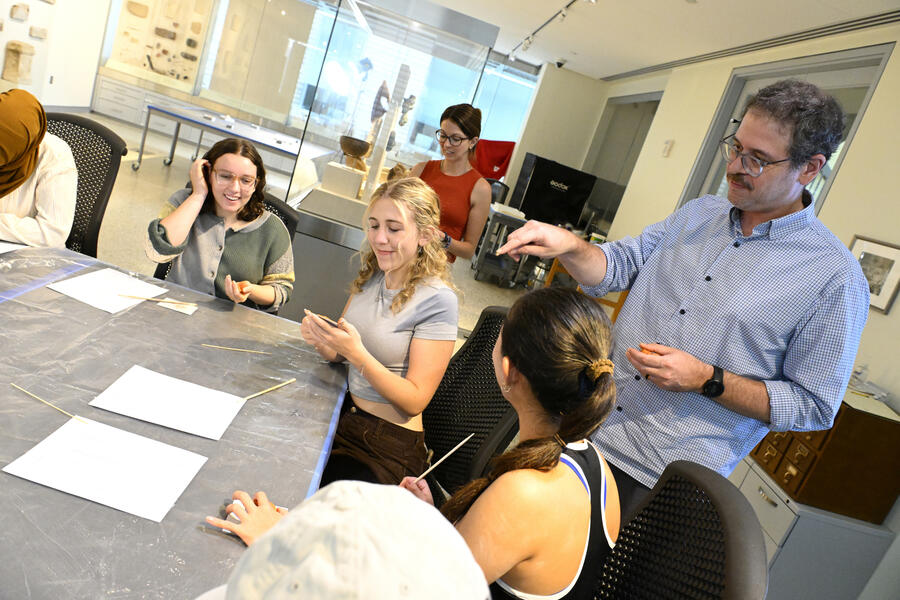Here's what we know about Zaze. She was a woman. She lived some 3,500 years ago in southeastern Turkey. And as the manager—or maybe owner—of a furniture workshop, she employed at least seven carpenters.
We know this to be true because Akkadian cuneiform reveals as much, epigrapher Jacob Lauinger marvels. An associate professor of Assyriology and director of graduate studies in the Department of Near Eastern Studies at Johns Hopkins University, he translates and teaches this ancient system of three-dimensional inscription that consists of around 600 signs characterized by wedge shapes with tails.
Scribes would have recorded Zaze's business dealings: orders for chairs, tables, and beds from the palace and people of the Kingdom of Alalakh. Using a stylus fashioned from a reed, they pressed shapes into soft clay tablets, creating signs for letters and words.
It's a rare privilege, Lauinger says, to hold an artifact that speaks to him from the 15th century BCE; notably one that puts him in direct touch with Bronze Age residents of the Amuq Valley of Hatay, near the present-day city of Antakya. Lately, he and doctoral student Zeynep Türker have been focused on Zaze because of a tablet that emerged in a most astounding way, at a most auspicious moment in time.
The fully intact tablet came to light amid chaos and ruin wrought by a series of earthquakes in February 2023 that leveled much of southeastern Turkey, notably the environs of ancient Alalakh, now known as the Tell Atchana archaeological site. The artifact apparently had washed down in a sea of rubble before being deposited at the ancient city gate.
"It is," Lauinger says, "a gift of continuity, of human knowledge and scholarship, of connection from past to present and future; a gift to those who suffered so much loss."
He tears up. His voice catches as he tries to express the huge significance of this tiny find. Measuring 1.7 inches by 1.4 inches and 0.6 inches thick, the pristine artifact contains a dozen decipherable lines of cuneiform depressed into its front and back.
"We can't specify the exact amount of furniture, or the types of furniture mentioned before we publish this research," says Türker, who has been integral in the translation process. "But we can say furniture—a lot of furniture."
This relic most certainly belongs to an archive of cuneiform tablets unearthed nearly a century ago by British archaeologist Sir Leonard Woolley, who was the first to excavate a fortress adjoining the city gate of Alalakh. In the finders-keepers fashion of colonial expeditions, Woolley took treasures home, leaving the pillaged palace complexes and associated structures to deteriorate.
Fast-forward to the early 2000s when Lauinger, then a grad student at the University of Chicago, was invited to assume the role of epigrapher during new excavations at the site. A lot had changed since Woolley's departure: A thick tangle of Syrian mesquite had grown over what was left of Tell Atchana's fragile mudbrick architecture, and, importantly, preservation and restoration work had become paramount within the evolving practice of archaeology.
A decade after K. Aslihan Yener started the renewed excavations in 2002, a team that included local students and area residents began transforming the site into an archaeological park. The surrounding community took pride in its pivotal role and benefited financially from participation in the project, according to Murat Akar, an associate professor of archaeology at Hatay Mustafa Kemal University. The laborious fieldwork necessary to restore the site to its ancient mudbrick glory was ongoing when the quake hit and resumed just months later, in the summer of 2023.
Then came the gift.
"The site offered up the tablet," Lauinger says.
The tablet became a tangible symbol of hope, healing, and comfort in the wake of a natural disaster that claimed more than 50,000 lives and left countless others injured, many of whom were children.
It's known that Zaze had a son. The newly discovered tablet doesn't mention him directly, but its content and format mirror others (excavated by Woolley) that record the activities in Zaze's workshop and refer to the son of Zaze. This revelatory phrasing implies a certain social/familial status: Instead of being affiliated with his father, as was customary during a time when there were no surnames, Zaze's child belonged to her. Not inconsequentially, that's how he's gone down through the ages.
The story of Zaze wholly captivates both Lauinger and Türker. "This woman, who probably seven people in the world know about," Lauinger says, "was an important person in her time." The tablet coming to light when and how it did is also a tale worth telling, Türker adds.
Also see
But these aren't the main reasons the enigmatic tablet has been getting press from the likes of CNN, NPR, and Forbes, Lauinger says. What piqued attention amounts to glib clickbait: Someone described the tablet as "a shopping list," reducing Zaze's tablet to an ancient Amazon order. "Our consumerist, capitalist society is like, 'Oh boy! I know about shopping lists! Let me look at an ancient one!'" Lauinger says.
What captures our stunted imaginations is us, he adds—the us of the past. This tendency to navel gaze—to stare at ourselves in a Bronze Age funhouse mirror—is antithetical to Lauinger's interest in "other modes of experiencing the world within the vast panoply of human experience."
As lead of the study of the tablet related to Zaze—set to undergo peer review in the near future—Türker is asserting herself among Assyriologists whose expertise is epigraphy—an insular field that Lauinger describes as dominated by white males from America and Western Europe.
It's vital that a diverse group of scholars pursues studies of the past, Lauinger says. "Otherwise we're just going to be saying the same thing over and over again."
Posted in Arts+Culture
Tagged archaeology, near eastern studies








